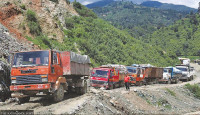Columns
Life during lockdown
The government should urge all institutions to draft business continuity and disaster recovery plans.
Sushil Poudel
Nepal has suspended on-arrival visas for tourists (including non-resident Nepalis), implemented swab PCR tests, compulsory home quarantine for returning migrants, foreign labour entry permits and no-objection certificates for students. It has also cancelled mountaineering permits and requested the public to avoid gatherings, and shut down all entry points. These response measures are based on nine priority areas of work prescribed in the World Health Organisation's Interim Guidance, and the government's decisions are bold steps to prevent chances of transmitting Covid-19.
Uncertainty about the exact time needed to completely beat the disease spread has led to a confidence crisis. Stocks, in free fall across the globe, show the rising uncertainty. Economies with close connections to virus-affected economies have been hit as a result of disturbances in the supply chain. Economists have started to fear that a global recovery will likely be L-shaped instead of V-shaped or U-shaped. The existence of business continuity plans will be a vital component in determining the shape of the recovery.
Contingency plans
A recent spike in coronavirus cases in India, as well as in foreign employment destinations popular among Nepalis, has alerted Nepal to go into a high level of preparedness to lessen the impact. Knowing the impact and intensity of disruptions in advance and preparing contingency plans for the crisis will lessen its impact. Economies faced disruptions in the workforce accompanied by disturbances in the supply chain that led to a decline in economic activities. Business continuity and disaster recovery plans will help to sustain institutions during the crisis and promptly restart normal business after it ends.
Clear continuity and disaster recovery plans should be drafted by every organisation to ensure continued operation during the crisis. The plans should focus on employee management, supply chain and priority areas of the organisation's activities that should be carried out at any cost. Economic losses should be kept to a minimum without compromising risks. The Nepal government should immediately urge all institutions to draft business continuity and disaster recovery plans and put them in action.
If a single employee is suspected of being infected with the coronavirus, all other employees are kept in quarantine, which could result in major disruption, to normal operations. Human resource policies have to be temporarily modified to ensure employees will not be personally impacted if they have to be quarantined for an extended period. The current lockdown may be extended again. The need now is greater flexibility in working arrangements. Organisations need to determine priorities and the minimum staffing requirements to support them in the event of a significant reduction in the workforce.
All organisations should provide sufficient sanitisation materials for daily use, have an adequate stock of protective masks to be used in emergencies and create a plan for temporary isolation of employees if a threat of possible infection arises, especially after the mandatory lockdown. A safe distance has be maintained between workers till the crisis ends. Work from home or remote locations should be introduced in all possible operations. For activities needing physical presence, rotation among the minimum required staff should be introduced to minimise the impact of disruption. As planning and decision making are major drivers of all organisation activities, the Nepal government should immediately issue an ordinance to give validity to virtual decision-making processes.
Focal persons, along with alternate candidates, should be appointed for coordination of activities among team members. Contingency plans for substitution of the coordinator and team members in case of sickness or inability to execute the responsibilities should be predefined. An effective communication plan for coordination during and after the end of the crisis should be in place. Personnel from the information technology department or anyone who can lead technological coordination should be identified and given key roles. IT personnel should also be able to provide instructions about the virtual operation of organisational activities.
Sufficient numbers of laptops, computers, monitors, keyboards and printers, communication facilities and internet service with the capability for group teleconferencing should be in place. Secure online file sharing, access to documents and systems along with alternate backup and disaster recovery should be assured by the IT department. Digital movement of documents should be preferred. The government should coordinate with internet service providers for quality data transfer service at a low cost during the crisis.
Necessary coordination with key vendors and outside parties including clients, shareholders, regulators and the media about the continuation of business should be thoroughly discussed and agreed upon. An alternative service provider, if the service is highly critical to business systems, should be planned to avoid disruption from vendor loss.
Tested and validated
The business continuity plan should be tested and validated regarding their effectiveness on an ongoing basis. It should be circulated among all employees to help identify gaps and provide inputs for successful execution. The plan will allow participants to be familiar with the objectives, and ensure that all parties understand their roles and responsibilities and apply their rational judgement in an alternate scenario instead of following the plan as strict guidelines.
Although there is no guarantee that the plan will help an immediate resumption of business operations in a crisis, creating a sound framework for implementation and control can help prepare Nepali firms and their employees to handle and manage significant disruptions to business operations related to Covid-19. An online business that is highly popular these days was the result of increased online shopping during the SARS and MERS epidemics in Southeast Asia. Implementing work from home, promoting digitisation of work and running organisations with fewer people without risking their health could be a successful tool for minimising economic losses during the crisis, and a lesson for enhancing productivity after it.
***
What do you think?
Dear reader, we’d like to hear from you. We regularly publish letters to the editor on contemporary issues or direct responses to something the Post has recently published. Please send your letters to [email protected] with "Letter to the Editor" in the subject line. Please include your name, location, and a contact address so one of our editors can reach out to you.




 21.12°C Kathmandu
21.12°C Kathmandu















